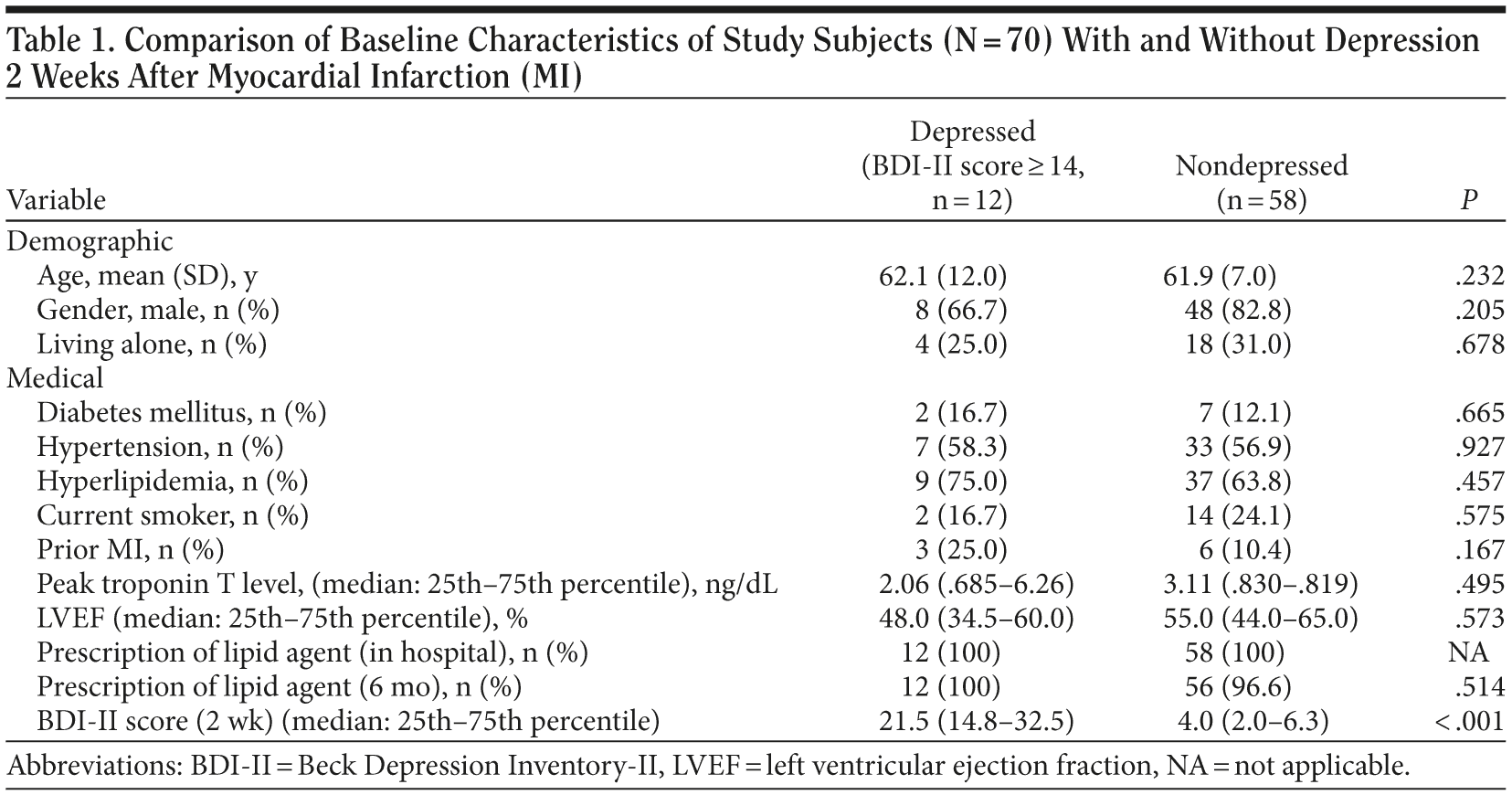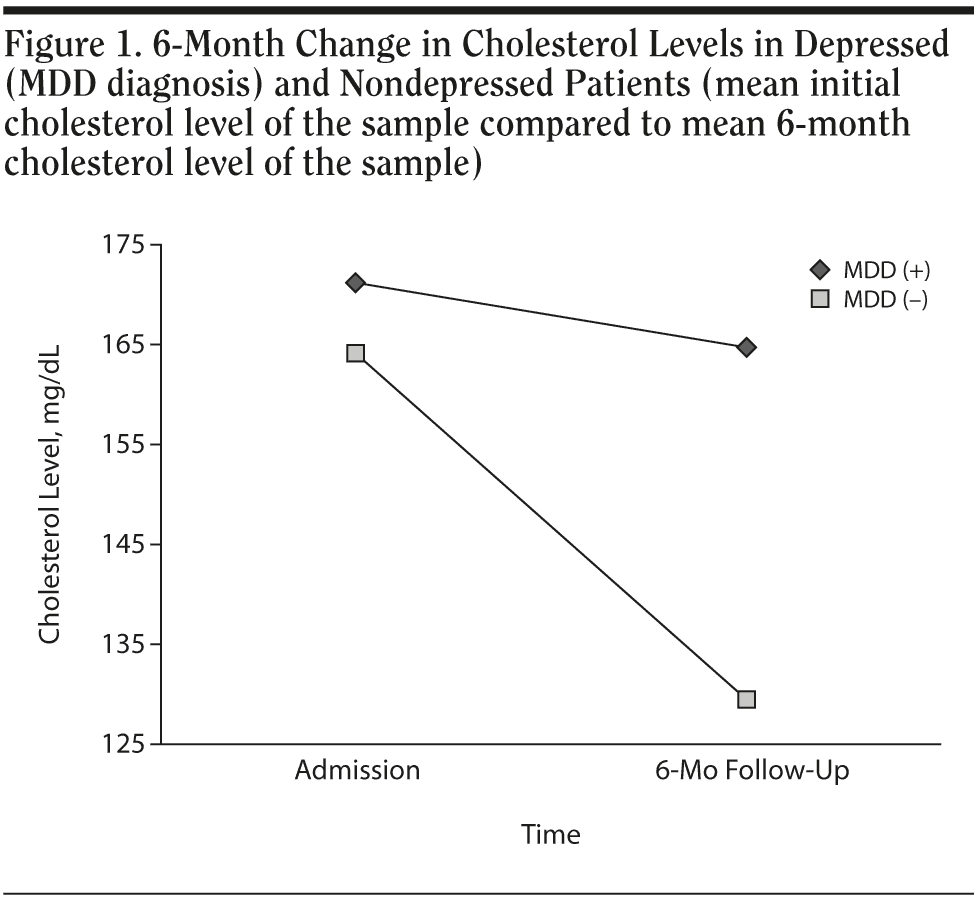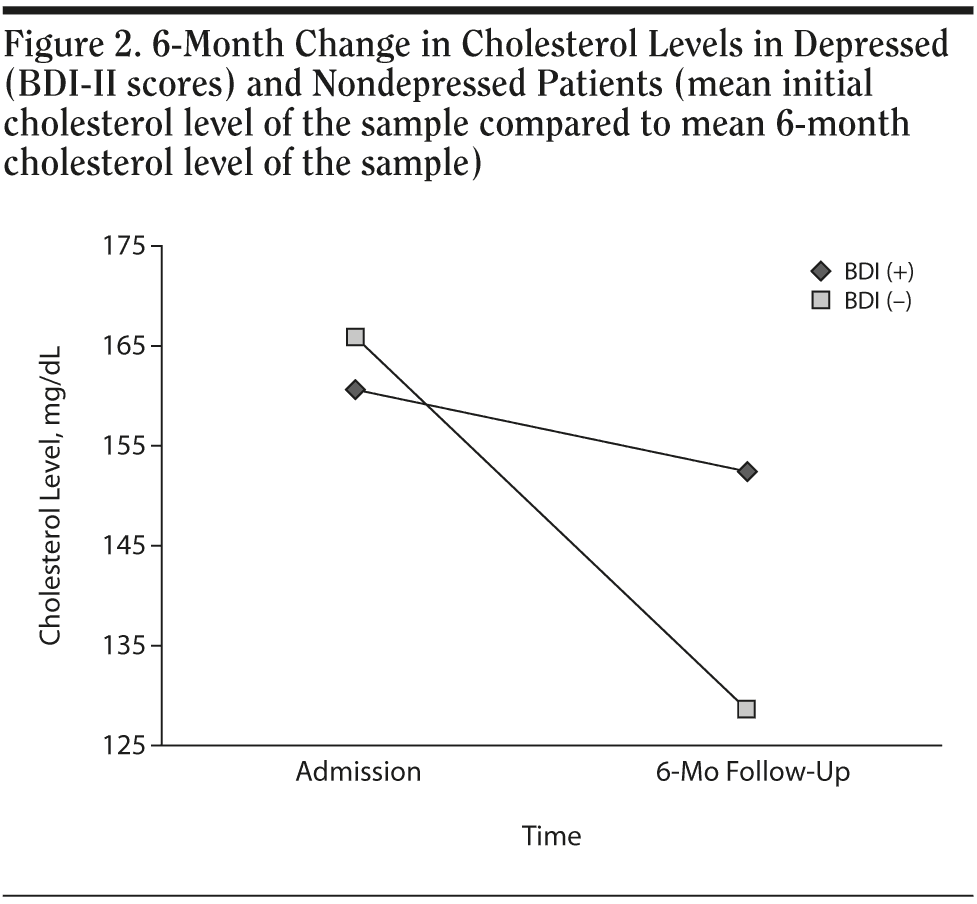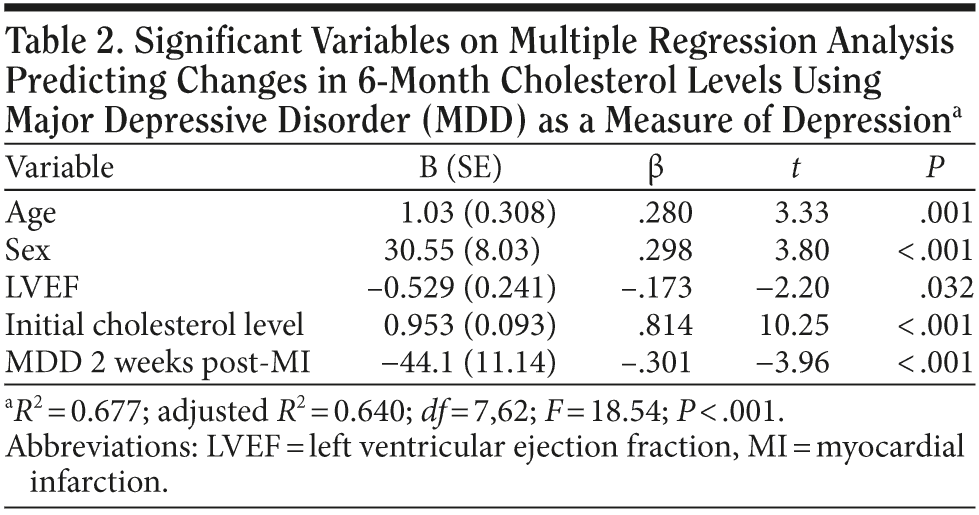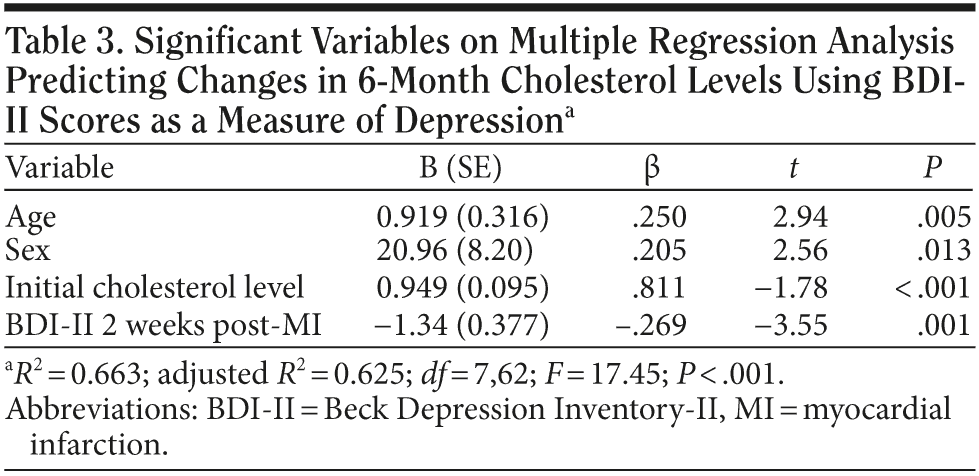Depression and Failure of Cholesterol Lowering After Acute Myocardial Infarction
Objective: Depression after acute myocardial infarction (MI) is independently associated with cardiac mortality, but the mechanism explaining this association remains unclear. To our knowledge, there has been no prior study exploring the impact of post-MI depression on lipid lowering, a key secondary prevention measure in post-MI patients. In this prospective observational cohort pilot study, we hypothesized that patients with early post-MI depression would have inferior cholesterol reduction 6 months post-MI compared to nondepressed patients.
Method: Patients admitted to a cardiac intensive care unit or a cardiac step-down unit between October 2003 and July 2005 were enrolled in the study within 72 hours of MI. Two weeks post-MI, subjects were assessed for depression using the module for current major depressive disorder (MDD) from the Structured Clinical Interview for DSM-IV Axis I Disorders (SCID) and the Beck Depression Inventory-II (BDI-II). Information regarding cholesterol levels was collected 6 months after MI.
Results: Initial and 6-month cholesterol levels were available for 70 subjects who had 2-week post-MI depression assessments. Post-MI depression, measured both using an interview for MDD and the BDI-II, was associated with inferior cholesterol reduction, with depressed subjects improving their cholesterol levels by approximately 8 mg/dL compared to a cholesterol reduction of 37 mg/dL in nondepressed subjects. Furthermore, depression diagnosed by formal MDD interview (β = -.301; P < .001) and the BDI-II (β = -.269; P = .001) continued to be associated with significantly smaller reductions in cholesterol levels on linear regression analyses that accounted for demographic and medical variables.
Conclusions: In this exploratory pilot study, early post-MI depression was independently associated with impaired lipid lowering 6 months after MI.
Prim Care Companion J Clin Psychiatry 2010;12(1):e1-e6
© Copyright 2010 Physicians Postgraduate Press, Inc.
Submitted: December 24, 2008; accepted February 22, 2009.
Published online: February 11, 2010 (doi:10.4088/PCC.08m00766blu).
Corresponding author: Jeff C. Huffman, MD, Massachusetts General Hospital, 55 Fruit St, Warren 1220C, Boston, MA 02114 ([email protected]).
A critical intervention for patients who have suffered acute myocardial infarction (MI) is the early and aggressive lowering of cholesterol levels. Cholesterol-rich atherosclerotic plaques underlie the primary mechanism for acute MI, and hyperlipidemia is a clear risk factor for the development of future MI.1 Furthermore, early and aggressive lowering of lipids following acute MI is associated with superior outcomes compared to a less aggressive lipid-lowering approach.2
Despite the favorable effects of aggressive lipid lowering, not all patients achieve target lipid levels following acute MI. The reasons for this finding are multifactorial; however, one phenomenon that may mediate impaired post-MI lipid lowering is depression, a common comorbid condition among post-MI patients. Depression following MI has been independently associated with cardiac morbidity and mortality in the months and years following the cardiac event.3 The mechanisms by which depression is linked with inferior cardiac outcomes are not yet fully clear but are likely a combination of depression’s physiologic effects on the cardiovascular system and impaired adherence to medical recommendations. With respect to these behavioral effects, post-MI patients with depression have been found to have significantly lower adherence to a low fat diet, exercise recommendations, and medications compared to nondepressed patients,4 potentially leading to impaired lipid lowering in these patients.
To our knowledge, no prior study has specifically evaluated the association of early post-MI depression with cholesterol lowering in the months after discharge. In this pilot study, we evaluated patients for depression in the early post-MI period and collected data on cholesterol levels 6 months after MI. We hypothesized that patients with early post-MI depression would have significantly less improvement of cholesterol levels at 6 months compared to post-MI patients without depression.
Clinical Points
- Depression appears to be associated with an inability to lower cholesterol levels after myocardial infarction (MI).
- To enhance lipid lowering in patients with depression after MI, clinicians should aggressively treat depression and maintain a focus on helping the patient adhere to recommendations for lipid lowering (eg, diet, exercise, and medication adherence).
METHOD
Procedures and Subjects
This exploratory prospective observational cohort study was approved by the Institutional Review Board of Massachusetts General Hospital, Boston. Patients admitted to the Massachusetts General Hospital Cardiac Intensive Care Unit or Cardiac Step-Down Unit between October 2003 and July 2005 with a primary diagnosis of MI were recruited and evaluated within 72 hours of symptom onset. For this pilot study, patients were not consecutively recruited; rather, unit physicians were regularly approached by study staff on weekdays to determine whether new MI patients had been admitted. If such a patient was identified, per Institutional Review Board regulations, treatment team members asked the eligible patient whether he or she was amenable to being approached for the study, after which full informed consent was obtained. Eligible patients met at least 2 of the 3 consensus criteria5 for an acute MI: typical chest pain, elevated cardiac biomarkers (troponin T ≥ 0.10 ng/mL or CPK-MB ≥ 1.5 times the upper limit of the normal range), and electrocardiographic changes consistent with MI.
Exclusion criteria included patients with peri-procedural MIs, patients who had cognitive difficulties precluding informed consent or completion of a psychiatric interview, and those too medically unstable to complete the interview. Patients with a current substance use disorder were also excluded to reduce the possibility of substance use as a cause of psychiatric symptoms.
Study staff performed telephone follow-up evaluations 2 weeks after initial entry into the study. To allow both categorical and continuous measures of depression, 2 depression instruments were used: (a) the module for current major depressive disorder (MDD) from the Structured Clinical Interview for DSM-IV Axis I Disorders (SCID)6 and (b) the Beck Depression Inventory-II (BDI-II).7
We selected formal diagnostic interview (via the SCID module for MDD) because it is the DSM-IV-based gold standard for a categorical diagnosis of depression and additionally used the BDI-II because it provides a continuous, quantitative measure of depression severity. The BDI-II was used as a continuous variable for the primary statistical analysis; when it was evaluated as a categorical variable (eg, for comparison of means in the preliminary analysis), a BDI-II score ≥ 14 was used as a cutoff for depression on the basis of the use of this cutoff in a prior study of cardiac patients.8
Experts have noted that some patients with depression in the immediate post-MI period (eg, in the hospital) have spontaneous improvement in depression scores.9 To ensure that patients’ depressive symptoms were persistent (rather than a transient syndrome ending shortly after discharge from the hospital), we measured depressive symptoms 2 weeks after MI and required subjects to meet full criteria for current MDD (ie, having symptoms of at least 2 weeks’ duration) at follow-up.
Chart Review
At the end of the hospitalization, subjects’ medical records were reviewed to obtain information regarding potential confounding variables to control for their effects on cholesterol levels at 6 months: age, gender, subjects’ admission cholesterol levels, prior history of hyperlipidemia, and left ventricular ejection fraction (LVEF) (as a measure of overall cardiac illness severity). As part of standard clinical care for MI patients, fasting cholesterol levels were obtained on the morning after admission, and the results were reported in, and collected from, the electronic medical record.
Cholesterol Data
At enrollment, subjects provided consent for study staff to contact their primary physician to gather medical information (eg, current medications, including lipid agents) and 6-month fasting cholesterol levels when obtained as part of clinical care. At the end of the 6-month study period, study questionnaires inquiring about medical information and cholesterol levels were faxed to the physicians’ offices and collected by study staff. In addition, we also collected data on whether subjects were prescribed lipid-lowering agents at 6 months to account for this variable in statistical analysis. Cholesterol subsets (high-density lipoprotein [HDL], low-density lipoprotein [LDL]) were not obtained as part of clinical care in a number of cases, and given the already small number of subjects in the trial, we thus chose to only evaluate total cholesterol levels for the purposes of this pilot study.
Statistical Analysis
Data analysis was carried out using SPSS for Windows, Release 16.0.1 (SPSS Inc, Chicago, Illinois). All statistical tests were 2-tailed, and a P value < .05 was considered significant.
Missing data. Cholesterol levels were not available for all subjects, and not every subject followed up with the depression evaluation. For this reason, we needed to determine whether cholesterol values/depression data were missing at random. We conducted a series of multiple logistic regression analyses with dichotomous variables (yes/no) for obtaining these data.
First, we attempted to determine if obtaining a 6-month cholesterol value (n = 81) was associated with obtaining 2-week depression data (n = 105). In this analysis, we used obtaining a 6-month cholesterol value as the dependent variable, and all relevant covariates were included in the model, including a dichotomous variable for obtaining 2-week depression data. Obtaining the 6-month cholesterol level was not associated with obtaining the 2-week depression data, suggesting that the data were missing at random. Next, we evaluated whether obtaining a 6-month cholesterol value was associated with 2-week BDI-II depression scores or initial cholesterol levels (ie, to determine whether depression or initial lipid levels predicted whether 6-month cholesterol values were obtained). With all covariates in the model, neither 2-week depression data nor initial cholesterol levels were associated with obtaining a 6-month cholesterol level, again suggesting that the data were missing at random. On the basis of these findings, use of the observed data in our primary analysis can be considered valid.
Comparison of mean changes in cholesterol levels (admission cholesterol level compared to 6-month cholesterol level) between depressed and nondepressed subjects. Descriptive statistics were compiled, and differences in the mean change in cholesterol levels (the mean initial cholesterol level for the study sample minus the mean 6-month cholesterol level for the sample) between depressed and nondepressed subjects were investigated using analysis of variance. In these initial comparisons, depression was defined categorically, with a first analysis using the SCID diagnosis of MDD to denote depression and a separate analysis using BDI-II scores at 2 weeks’ post-MI (with a score ≥ 14 used as a cutoff for depression).
Primary analysis: exploration of independent associations between post-MI depression and change in cholesterol levels. We performed 2 sets of analyses via multiple linear regression to determine the relationship between post-MI depression at 2 weeks and the change in cholesterol levels at 6 months, adjusting for possible confounders. We first used formal MDD diagnosis to define depression and then used BDI-II scores (as a continuous variable) to define depression.
To avoid overfitting given the sample size,10 6 covariates in addition to 2-week depression data were included in the adjusted model. These 6 covariates were age, gender, prior history of hyperlipidemia, admission cholesterol level, LVEF, and taking a lipid-lowering agent at 6 months. All variables included in the linear regression were entered in hierarchical fashion, with demographic variables (age, gender) entered in the first block, medical/cardiac variables (initial cholesterol level, hyperlipidemia, lipid-lowering agent prescription at 6 months, and LVEF) entered in the second block, and the psychological variable (MDD or BDI-II scores) entered last.
RESULTS
One hundred thirty-one subjects enrolled in the initial study. Two subjects were excluded from participation in this analysis because they did not have LVEF data available. Of the 81 subjects who had cholesterol levels, 2-week follow-up data were obtained for 70 (86.4%) of the subjects. Approximately 9% had persistent MDD at 2 weeks, and 17% had an elevated (≥ 14) 2-week BDI-II score. Baseline characteristics of subjects with and without current BDI-II depression are compared in Table 1. There were no significant differences in measured baseline demographic or medical variables between depressed and nondepressed subjects, and characteristics were similar for those with and without SCID-diagnosed current MDD. All subjects were prescribed lipid-lowering agents (statins) at discharge, and nearly all (97.1%) were prescribed statins at 6 months, including all subjects who met depression criteria by MDD diagnosis or BDI-II score.
Comparison of Mean Changes in Cholesterol Levels
We first used the SCID diagnosis of MDD as a measure of depression comparing mean 6-month change in cholesterol levels between those patients with and without MDD at 2-week follow-up (Figure 1). The nondepressed subjects’ (n = 64) change in cholesterol (initial: 164.2 mg/dL; 6 months: 129.6 mg/dL; change: 34.6 mg/dL [21.1%]) was greater than that seen in depressed subjects (initial: 171.2 mg/dL; 6 months: 164.7 mg/dL; change: 6.5 mg/dL [3.8%]). Total 6-month cholesterol levels were significantly higher in the depressed group (F = 8.13; P = .006), although between-group differences in the change in cholesterol levels were not significant (F = 2.61; P = .11) given the small number of depressed subjects.
We then used BDI-II scores as a measure of depression (Figure 2) using a BDI-II score ≥ 14 as a cutoff for depression. Subjects without depression at 2 weeks (n = 58) had a mean decrease in cholesterol from 165.7 mg/dL (initial) to 128.5 mg/dL (6 months), representing a drop of 37.2 mg/dL (22.5%). Subjects with depression at 2 weeks via BDI-II (n = 12) had a mean decrease in cholesterol from 160.5 mg/dL to 152.2 mg/dL, a drop of 8.3 mg/dL (5.2%). The depressed group had significantly higher 6-month cholesterol levels (F = 6.55; P = .013) and a significantly smaller change in cholesterol levels (F = 5.14; P = .027).
Primary Analysis: Predictors of Change in Cholesterol Values
On linear regression analysis that accounted for age, gender, prior hyperlipidemia, initial cholesterol level, LVEF, and taking a lipid-lowering agent at 6 months, current depression remained negatively and independently associated with change in cholesterol levels at 6 months, whether depression was measured via formal MDD diagnosis (β = -.301; P < .001; Table 2) or via the BDI-II (β = -.269; P = .001; Table 3).
DISCUSSION
While depression is known to be associated with worse cardiac outcomes following acute MI, the mechanisms underlying this association remain elusive. While several plausible mechanistic possibilities exist,11 one natural area of focus is the possibility that depression could be linked to impaired secondary prevention behaviors such as cholesterol reduction.
In this preliminary pilot study, we found that patients with depression (measured via formal MDD diagnosis or BDI-II scores) 2 weeks following acute MI had significantly smaller reductions in cholesterol levels at 6 months compared to those patients who were not depressed. Although the total number of subjects was small, the numeric differences in cholesterol lowering were substantial, as nondepressed patients lowered cholesterol levels in the 6 months post-MI by approximately 37 mg/dL, while depressed patients lowered their cholesterol levels by 8 mg/dL. The association between post-MI depression and 6-month cholesterol change remained significant even when accounting for important demographic and medical variables and despite the fact that all depressed patients were prescribed statins. This finding suggests that a special focus on lipid-lowering measures may be indicated in patients with post-MI depression.
Although many MI patients in the study had “normal” cholesterol levels, the mean initial cholesterol level of the group was greater than 160 mg/dL. Data from the Framingham Heart Study suggest that cholesterol levels above this threshold increase risk of cardiac events even among those without prior MI.12 Furthermore, prior studies have found that statins reduce mortality in coronary heart disease patients across a wide spectrum of initial cholesterol levels even among those considered normal.13
Why did depressed patients have inferior cholesterol reduction? Although we did not explore mechanisms in this pilot study, there are behavioral and physiologic possibilities. Prior studies have evaluated the effects of post-MI depression on secondary prevention behavior. Ziegelstein and colleagues4 found depression post-MI to be associated with significantly reduced adherence to a low fat diet, exercise, and medication. Fadl and colleagues14 found that post-MI depression has been associated with inability to lose weight among overweight patients, and several authors have found that patients with post-MI depression may be less likely to attend,15 or continue with,16 cardiac rehabilitation programs. Our results, using a more objective marker of cardiac risk, may support the notion that the link between post-MI depression and cardiac mortality is at least in part mediated by behavioral mechanisms impacting health maintenance behaviors. Depression may also have physiologic effects that could lead to elevated cholesterol levels. For example, MDD is associated with hypothalamic-pituitary-adrenal axis hyperactivity,17 which can lead to hypercortisolemia and, ultimately, hyperlipidemia.
To our knowledge, this is the first study to evaluate the link between post-MI depression and objectively measured changes in cholesterol levels. At the same time, this pilot study had several limitations. First, the study was limited by a small and selected number of subjects; however, the characteristics of subjects for whom cholesterol levels were and were not obtained were largely similar, suggesting that this cohort of patients was likely representative of the sample as a whole. Subjects were recruited nonconsecutively as a convenience sample and were only approached on weekdays; these methods may have led to an unaccounted-for selection bias. Cholesterol levels were obtained as part of usual clinical care instead of uniformly through a research protocol, and LDL and HDL levels were not available uniformly to allow for analyses of these levels.
In conclusion, this preliminary study found that depression shortly after MI is independently associated with significantly smaller changes in cholesterol levels measured 6 months after the acute cardiac event despite prescription of lipid-lowering agents. Future studies should confirm these findings in a larger cohort, include measures of LDL and HDL levels, and assess medication adherence as a potential mediating factor.
Author affiliations: Department of Psychiatry (Drs Huffman, Smith, Fricchione, and Pirl and Ms Nadelman) and Department of Cardiology (Dr Januzzi), Massachusetts General Hospital and Harvard Medical School (Drs Huffman, Smith, Fricchione, Januzzi, and Pirl), Boston.
Potential conflicts of interest: Dr Januzzi has served as a consultant to Roche Diagnostics and Siemens; has received grant/research support from Critical Diagnosis, Roche Diagnostics, and Siemens; and has served on the speakers’ or advisory boards of Roche Diagnostics and Siemens. Drs Huffman, Smith, Fricchione, and Pirl and Ms Nadelman report no financial or other affiliations relevant to the subject of this article.
Funding/support: This study was supported by the Kaplen Fellowship Award Grant and the Livingston Fellowship Award Grant, both through Harvard Medical School, Boston, Massachusetts.
Previous presentation: Portions of these data were presented at the Annual Meeting of the Academy of Psychosomatic Medicine; Miami, Florida; November 21, 2008.
REFERENCES
1. Saito D, Shiraki T, Oka T, et al. Rizsk factors indicating recurrent myocardial infarction after recovery from acute myocardial infarction. Circ J. 2002;66(10):877-880. doi:10.1253/circj.66.877
2. Cannon CP, Braunwald E, McCabe CH, et al. Intensive versus moderate lipid lowering with statins after acute coronary syndromes. N Engl J Med. 2004;350(15):1495-1504. doi:10.1056/NEJMoa040583
3. van Melle JP, de Jonge P, Spijkerman TA, et al. Prognostic association of depression following myocardial infarction with mortality and cardiovascular events: a meta-analysis. Psychosom Med. 2004;66(6):814-822. doi:10.1097/01.psy.0000146294.82810.9c
4. Ziegelstein RC, Fauerbach JA, Stevens SS, et al. Patients with depression are less likely to follow recommendations to reduce cardiac risk during recovery from a myocardial infarction. Arch Intern Med. 2000;160(12):1818-1823. doi:10.1001/archinte.160.12.1818
5. The Joint European Society of Cardiology/American College of Cardiology Committee. Myocardial infarction redefined: a consensus document of the Joint European Society of Cardiology/American College of Cardiology Committee for the redefinition of myocardial infarction. Eur Heart J. 2000;21(18):1502-1513. doi:10.1053/euhj.2000.2305
6. Williams JB, Gibbon M, First MB, et al. Structured Clinical Interview for DSM-IV Axis I Disorders (SCID). Washington, DC: American Psychiatric Press Inc; 1996.
7. Beck AT, Steer RA, Brown GK. Manual for Beck Depression Inventory-II. San Antonio, TX: Psychological Corporation; 1996.
8. Lespérance F, Frasure-Smith N, Koszycki D, et al. Effects of citalopram and interpersonal psychotherapy on depression in patients with coronary artery disease: the Canadian Cardiac Randomized Evaluation of Antidepressant and Psychotherapy Efficacy (CREATE) trial. JAMA. 2007;297(4):367-379. doi:10.1001/jama.297.4.367
9. Glassman AH, O’ Connor CM, Califf RM, et al. Sertraline treatment of major depression in patients with acute MI or unstable angina. JAMA. 2002;288(6):701-709. doi:10.1001/jama.288.6.701
10. Babyak MA. What you see may not be what you get: a brief, nontechnical introduction to overfitting in regression-type models. Psychosom Med. 2004;66(3):411-421. doi:10.1097/01.psy.0000127692.23278.a9
11. Skala JA, Freedland KE, Carney RM. Coronary heart disease and depression: a review of recent mechanistic research. Can J Psychiatry. 2006;51(12):738-745.
12. National Cholesterol Education Program (NCEP) Expert Panel on Detection, Evaluation, and Treatment of High Blood Cholesterol in Adults (Adult Treatment Panel III). Third Report of the National Cholesterol Education Program (NCEP) Expert Panel on Detection, Evaluation, and Treatment of High Blood Cholesterol in Adults (Adult Treatment Panel III) final report. Circulation. 2002;106(25):3143-3421.
13. Prevention of cardiovascular events and death with pravastatin in patients with coronary heart disease and a broad range of initial cholesterol levels. The Long-Term Intervention with Pravastatin in Ischaemic Disease (LIPID) Study Group. N Engl J Med. 1998;339(19):1349-1357. doi:10.1056/NEJM199811053391902
14. Fadl YY, Krumholz HM, Kosiborod M, et al. Predictors of weight change in overweight patients with myocardial infarction. Am Heart J. 2007;154(4):711-717. doi:10.1016/j.ahj.2007.06.006
15. Lane D, Carroll D, Ring C, et al. Predictors of attendance at cardiac rehabilitation after myocardial infarction. J Psychosom Res. 2001;51(3):497-501. doi:10.1016/S0022-3999(01)00225-2
16. Glazer KM, Emery CF, Frid DJ, et al. Psychological predictors of adherence and outcomes among patients in cardiac rehabilitation. J Cardiopulm Rehabil. 2002;22(1):40-46. doi:10.1097/00008483-200201000-00006
17. McQuade R, Young AH. Future therapeutic targets in mood disorders: the glucocorticoid receptor. Br J Psychiatry. 2000;177:390-395. doi:10.1192/bjp.177.5.390
